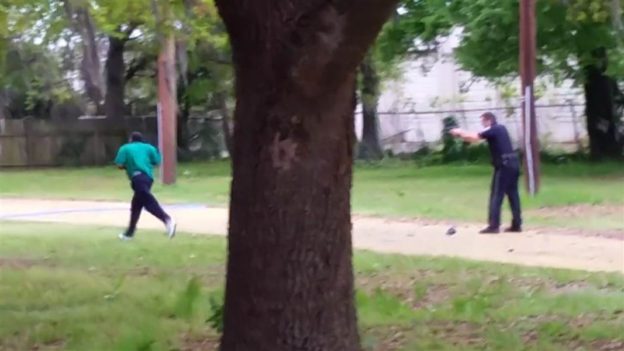It’s probably safe to say that not since the 26 seconds Abraham Zapruder filmed of President Kennedy’s assassination in Dallas in 1963 has a moving image of a killing been viewed more often than that of the April, 2015 fatal encounter, in North Charleston, South Carolina, between police officer Michael Slager and motorist Walter Scott.
The 50-year-old Mr. Scott was pulled over by Mr. Slager for a broken brake light. For reasons unknown, the motorist left his car and fled. The policeman shot and killed him.
The report filed by the officer report stated that he had deployed a Taser against Mr. Scott to stop him from fleeing, that the two men then struggled over the electrical shock device, that Mr. Scott gained control of it and attempted to use it against Mr. Slager, prompting the officer to shoot eight rounds at Mr. Scott, striking him five times.
A passerby caught the event on his mobile phone camera and, after hesitating for fear for his own safety, made the recording public.
The video clip showed Mr. Scott running away, nothing in his hands, and Mr. Slager, at a distance of 15-20 feet, coolly shooting at the back of the fleeing man. The film also seemed to show the officer, after the victim had fallen, retrieving something, possibly a Taser, from his patrol car and placing it next to the dying Mr. Scott.
Last week, a jury in Mr. Slager’s state trial (whose members had the option of finding him guilty of either murder or manslaughter), after 22 hours’ deliberation and repeated viewings of the video, remained deadlocked. Reportedly, 11 of the 12 jurors favored a conviction.
The Gemara (Sanhedrin, 17a) teaches us that when the Sanhedrin judged a capital case, a unanimous verdict would automatically be vacated. (For the reason, see Rashi and the Maharatz Chayes.) Unanimity, when a life is at stake, is unacceptable.
In American federal felony trials, however, as well as in trials on serious charges in various states, South Carolina among them, a unanimous verdict is required. And so, faced with the deadlock in the Slager case, the presiding judge declared a mistrial, and the lead prosecutor announced her intent to retry the defendant.
Most of us, and rightly, are sympathetic to police officers when they feel compelled to use their weapons. Police live dangerous lives, and many have been murdered in the course of their duties protecting us all. And in many of the cases where white officers like Mr. Slager have been accused of needlessly shooting black suspects like Mr. Scott, we tend to think that things aren’t always – excuse the expression – black and white.
Sometimes, though, they are.
Whether or not, as some have charged, the holdout in the jury box was motivated by racism, the video makes undeniably clear that Mr. Scott was unarmed and fleeing, and that Mr. Slager shot him at a distance, repeatedly, in the back.
Many African-Americans, unfortunately, automatically assume that if a white police officer shoots a black man it must have been because black lives don’t matter to white cops. That assumption is misguided; it ignores the inherent and considerable dangers of police work and the disproportionate representation of black men in criminal activity, resulting in a heightened sense of threat some officers might have when confronting them. (That’s not an excuse, only a reality.)
But disabusing those who jump to such conclusions about police shootings requires diligently investigating each case where a black person is hurt or killed by a police officer, and vigorously prosecuting any officer accused of using force wrongfully. As seems clearly to have happened, lethally, in the Slager case.
North Charleston’s police chief Eddie Driggers understands the importance of that. After watching the video, he minced no words, saying simply, “I was sickened by what I saw.”
Michael Slager will be retried by the state, and also faces federal charges of violating Mr. Scott’s civil rights and using a weapon during the commission of a crime. Usually, it is unjustified to expect a particular verdict. Usually, the public isn’t privy to what is needed to judge an accused person innocent or guilty. Usually, there is no way for people, even members of a jury who have heard much testimony and weighed much evidence, to know what in fact took place.
This, though, is not a usual case. And its outcome could help reassure American minorities that they are treated the same as everyone else in our country, or help confirm their worst suspicions.
© 2016 Hamodia
